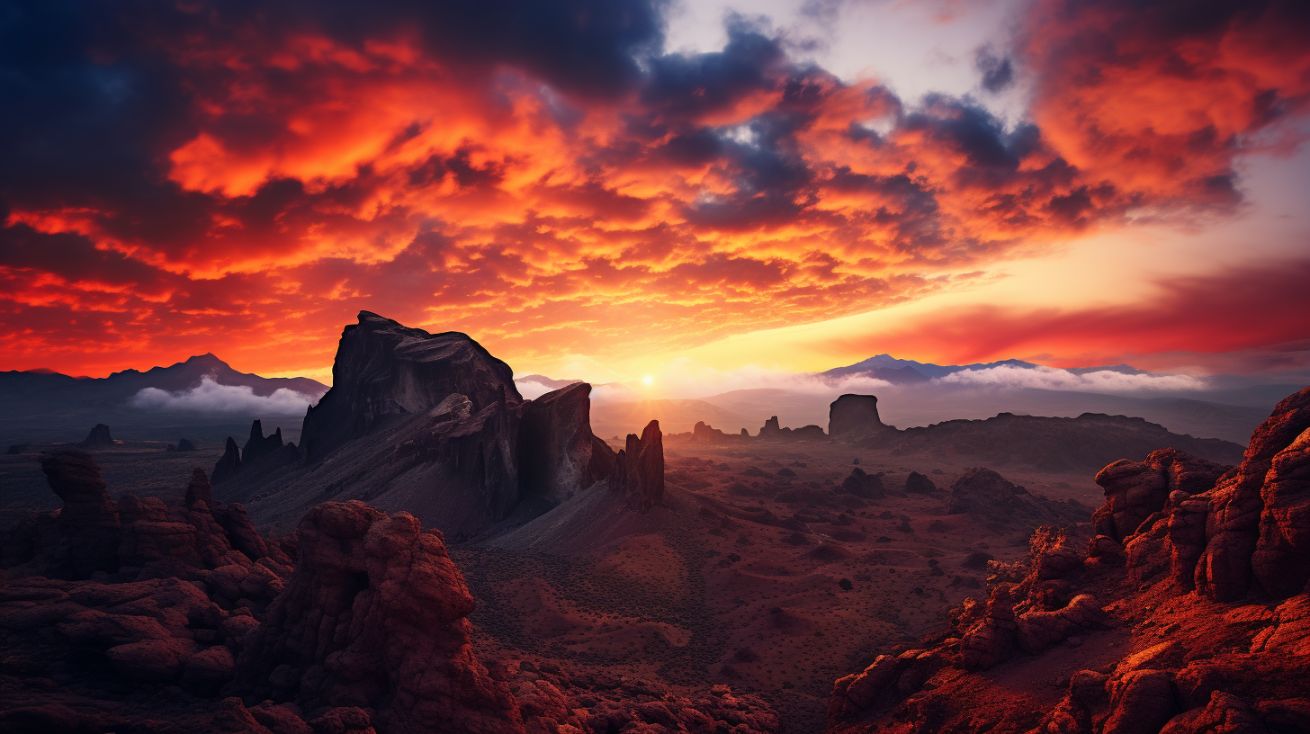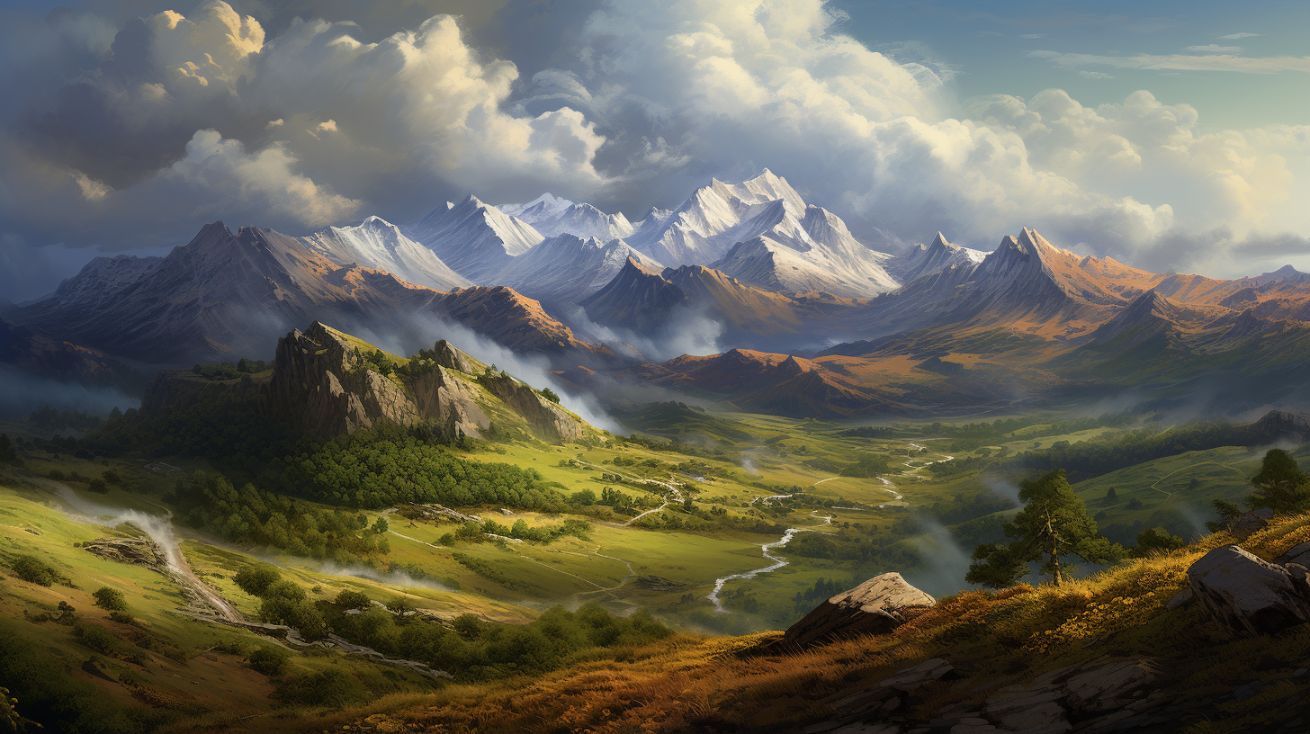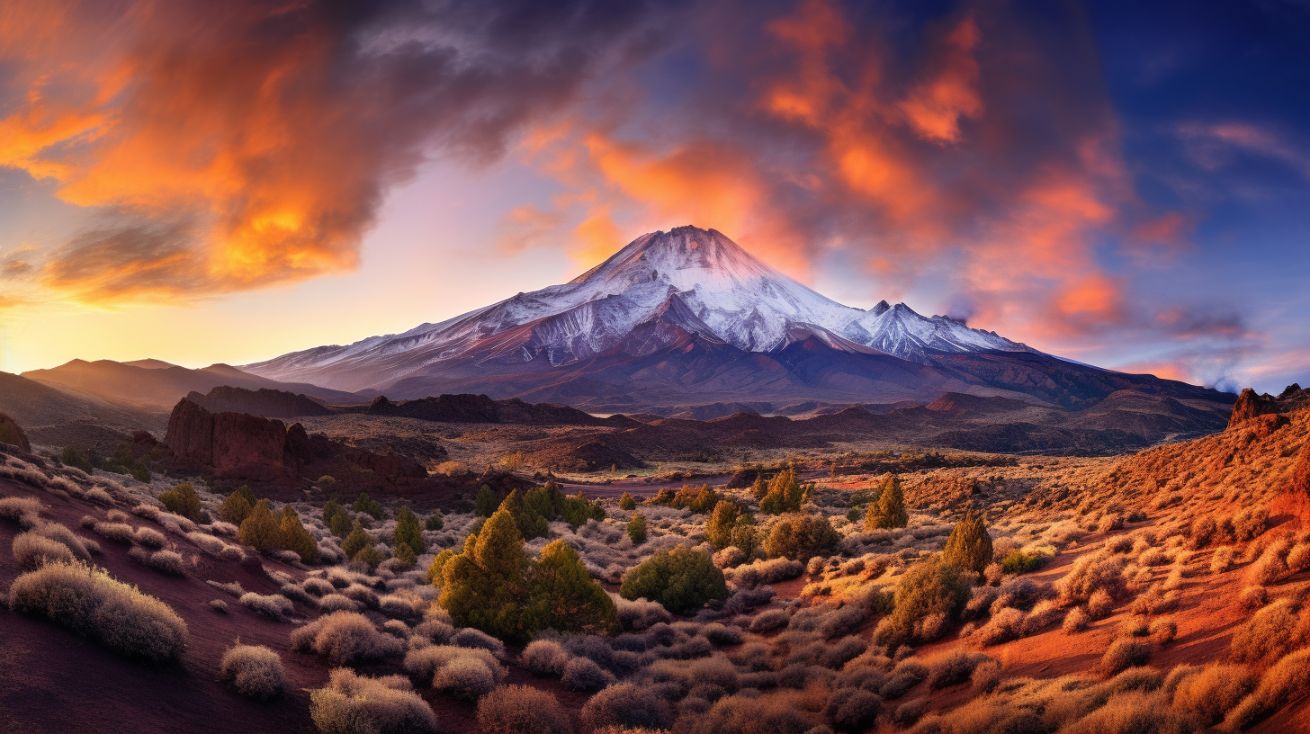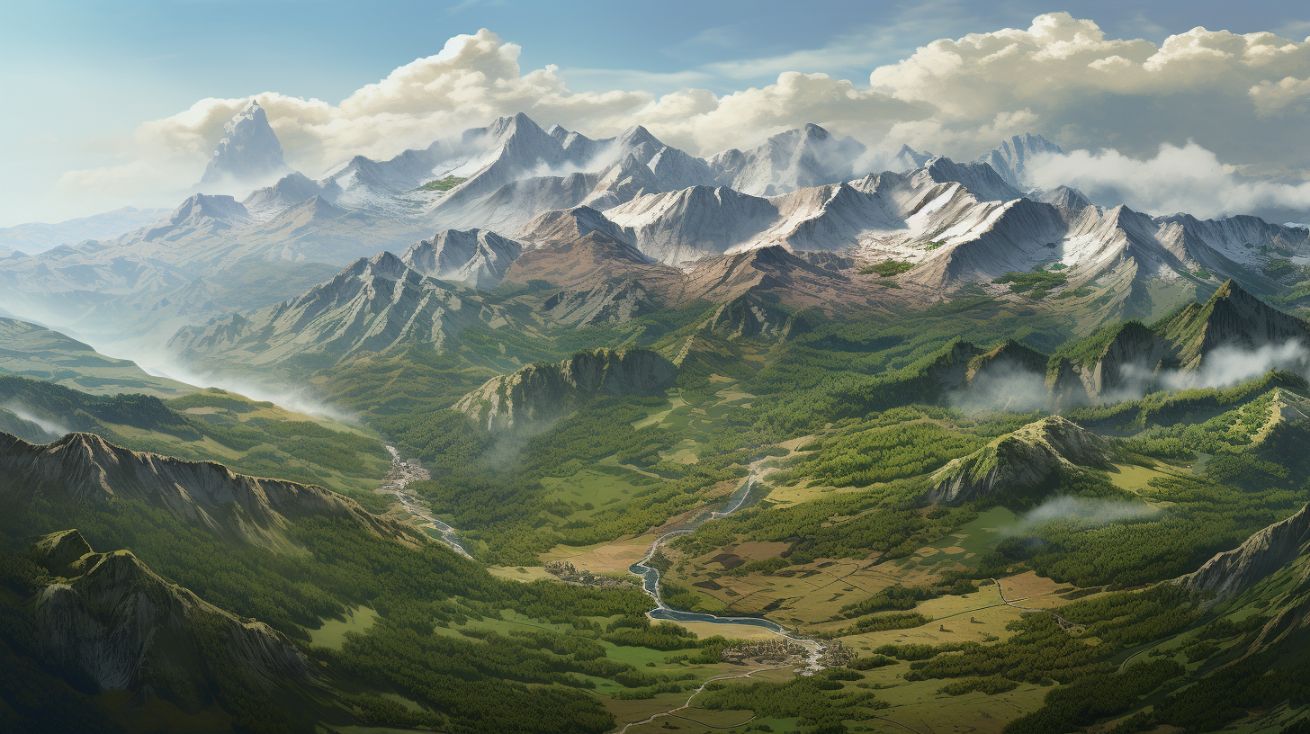As a geographer and an aficionado of Spanish culture and fan of mountain life, I’ve always been fascinated by the Major Mountains in Spain.
They make up nearly a quarter of the country, with heights reaching over 1,000 meters.
These grand formations aren’t just spectacular to behold; they’re vital for biodiversity, tourism and conservation efforts in Spain. Yet they’re under threat from climate change’s impact on water cycles.
Join me as we explore these magnificent mountains – their geography, ecosystems and cultural significance – while relishing our love for freedom amidst nature’s grandeur. These truly are some of the best places to be explored in Spain!
Table of Contents

Geographical Overview Of The Major Mountains In Spain
Did you know that Spain is essentially one giant mountain range, with a whopping 24% of the country soaring above 1,000 meters? Let’s explore!
This geographical marvel rests in southwestern Europe and holds the title of the largest country in southern Europe. Its diverse terrain stretches over a total area of 505,990 square kilometres, making it not only the second-largest country in Western Europe but also the fourth-largest in Europe.
The highest mountains in Spain are a sight to behold. Peaks such as Mount Teide, Mulhacen, Veleta, and the beautiful mountain Aneto dominate its skyline. These titans stand tall within prominent ranges including the Sierra Nevada and the Pyrenees. Each mountain tells its own tale; Mount Teide, for instance, is an active volcano nestled within the Canary Islands’ most visited natural site – Teide National Park.
These towering peaks don’t just add to Spain’s dramatic landscapes but also promote tourism by attracting nature lovers from across the globe. They’re more than just pretty sights though – they’re home to vibrant ecosystems bristling with life.
So if you’re yearning for freedom and adventure, remember: there’s no place quite like the mountains in Spain!
Major Mountain Ranges In Spain
Whether you’re an avid climber or simply a nature lover, you’ll be blown away by the stunning beauty of the Sierra Nevada and Pyrenees ranges! These major mountain ranges in Spain offer breathtaking landscapes that embody freedom and adventure.
The Sierra Nevada range, home to Mulhacén, the highest peak within Spain at 11,411 feet tall, is truly a sight to behold. I’ve marvelled at its snow-capped peaks from afar while sipping café con leche in Granada.
The Pyrenees range forms a natural barrier between Spain and France.
Here lies Mount Aneto standing tall at 11,165 feet with its glacier – an awe-inspiring jewel of Mother Nature’s creation. Walking along its trails gives me an exhilarating sense of liberation as I immerse myself in the raw beauty of this mountain range between France and Spain.
Then there are other ranges like Cordillera Cantabria and Sistema Iberico that add to Spain’s rich geographical tapestry. Each ‘Sierra de’ or mountain range carries a distinct identity shaped by centuries-old history and culture.
So when you venture into these Spanish mountains, remember it’s not just about scaling heights but also exploring depths – depths of nature’s majesty and cultural heritage.

Spectacular Mountain Ranges in Spain
Sierra Nevada
- Highest Peak: Mount Mulhacén
- Elevation: 3,479 meters or 11,414 feet
- Average Temperature: -5°C in winter, 10°C in summer
- Rainfall: Around 900 mm per year
- Best Time to Visit: July to September
- Climbing Difficulty: Moderate-Difficult
- Region: Andalusia
- Closest City: Granada
- Additional Information: Sierra Nevada is home to Mount Mulhacén, which is the highest mountain in mainland Spain and the third highest in Europe.
Pyrenees
- Highest Peak: Pico de Aneto
- Elevation: 3,404 meters or 11,168 feet
- Average Temperature: -10°C in winter, 10°C in summer
- Rainfall: Around 1,000 mm per year
- Best Time to Visit: June to September
- Climbing Difficulty: Difficult
- Region: Aragon
- Closest City: Huesca
- Additional Information: The Pyrenees mountain range is home to Pico de Aneto, the highest peak in the Pyrenees and often covered in snow due to its northern location. It also includes other notable peaks like Pico de Posets, Pico de Monte Perdido, Pico de la Maladeta, and Pico de Marbore.
Sierra de Gredos
- Highest Peak: Pico Almanzor
- Elevation: 2,591 meters or 8,501 feet
- Average Temperature: 0°C in winter, 15°C in summer
- Rainfall: Around 850 mm per year
- Best Time to Visit: June to October
- Climbing Difficulty: Moderate-Difficult
- Region: Castilla y León
- Closest City: Avila
- Additional Information: Sierra de Gredos is home to Pico Almanzor, the highest peak in the central system.
Montes de Toledo
- Highest Peak: Rocigalgo
- Elevation: 1,447 meters or 4,747 feet
- Average Temperature: Varies by season
- Rainfall: Varies by season
- Best Time to Visit: Varies by season
- Climbing Difficulty: Varies by season
- Region: Castilla-La Mancha
- Additional Information: Montes de Toledo is a mountain range located in the region of Castilla-La Mancha. Its highest peak, Rocigalgo, offers scenic views of the surrounding landscape. The range is known for its rugged beauty, diverse flora, and historical significance.
Sistema Central
- Highest Peak: Pico Almanzor
- Elevation: 2,591 meters or 8,501 feet
- Average Temperature: 0°C in winter, 15°C in summer
- Rainfall: Around 850 mm per year
- Best Time to Visit: June to October
- Climbing Difficulty: Moderate-Difficult
- Region: Castilla y León
- Closest City: Avila
- Additional Information: Sistema Central is the mountain range that includes the Sierra de Gredos, where Pico Almanzor is located.
Cordillera Cantábrica
- Highest Peak: Torre de Cerredo
- Elevation: 2,648 meters or 8,688 feet
- Average Temperature: Varies by region
- Rainfall: Varies by region
- Best Time to Visit: Varies by region
- Climbing Difficulty: Varies by region
- Region: Northern Spain
- Additional Information: Cordillera Cantábrica is a mountain range in northern Spain, and its highest peak is Torre de Cerredo.
Sierra de Cazorla
- Highest Peak: Pico de la Empanada
- Elevation: 2,106 meters or 6,909 feet
- Average Temperature: Varies by season
- Rainfall: Varies by season
- Best Time to Visit: Varies by season
- Climbing Difficulty: Varies by season
- Region: Andalusia
- Closest City: Cazorla
- Additional Information: Sierra de Cazorla is a mountain range located in Andalusia, and its highest peak is Pico de la Empanada.
Sierra de Guadarrama
- Highest Peak: Peñalara
- Elevation: 2,428 meters or 7,965 feet
- Average Temperature: Varies by season
- Rainfall: Varies by season
- Best Time to Visit: Varies by season
- Climbing Difficulty: Varies by season
- Region: Madrid and Castilla y León
- Additional Information: Sierra de Guadarrama is a mountain range situated near the capital city of Madrid in central Spain. Its highest peak, Peñalara, offers beautiful hiking and climbing opportunities.
Sierra de Grazalema
- Highest Peak: El Torreón
- Elevation: 1,654 meters or 5,426 feet
- Average Temperature: Varies by season
- Rainfall: Varies by season
- Best Time to Visit: Varies by season
- Climbing Difficulty: Varies by season
- Region: Andalusia
- Additional Information: Sierra de Grazalema is a picturesque mountain range located in Andalusia, known for its lush vegetation, caves, and canyons. El Torreón is the highest peak within this range.
Sierra Blanca
- Highest Peak: La Concha
- Elevation: 1,215 meters or 3,986 feet
- Average Temperature: Varies by season
- Rainfall: Varies by season
- Best Time to Visit: Varies by season
- Climbing Difficulty: Moderate
- Region: Andalusia (Málaga)
- Additional Information: Sierra Blanca is a mountain range located in the region of Andalusia, specifically in the province of Málaga. Its highest peak is known as La Concha, standing at an elevation of 1,215 meters or 3,986 feet. Sierra Blanca offers stunning views of the Mediterranean coastline, the city of Marbella, and the surrounding natural landscapes. It provides opportunities for hiking, nature walks, and outdoor activities in a beautiful setting.
Serra de Tramuntana
- Highest Peak: Puig Major
- Elevation: 1,445 meters or 4,741 feet
- Average Temperature: Varies by season
- Rainfall: Varies by season
- Best Time to Visit: Varies by season
- Climbing Difficulty: Varies by season
- Region: Balearic Islands (Mallorca)
- Additional Information: Sierra de Tramuntana is a stunning mountain range that runs along the northwest coast of Mallorca, one of the Balearic Islands. Puig Major is the highest peak on this island and within the range.
Sierra de Almijara
- Highest Peak: Cerro de la Cautiva
- Elevation: 2,068 meters or 6,785 feet
- Average Temperature: Varies by season
- Rainfall: Varies by season
- Best Time to Visit: Varies by season
- Climbing Difficulty: Varies by season
- Region: Andalusia
- Additional Information: Sierra de Almijara is a mountain range located in Andalusia, near the coast of the Mediterranean Sea. Cerro de la Cautiva is the highest peak within this range.
Sierra de Aracena
- Highest Peak: Cerro del Castaño
- Elevation: 960 meters or 3,149 feet
- Average Temperature: Varies by season
- Rainfall: Varies by season
- Best Time to Visit: Varies by season
- Climbing Difficulty: Varies by season
- Region: Andalusia
- Additional Information: Sierra de Aracena is a mountain range situated in the western part of Andalusia. Cerro del Castaño is the highest peak within this range, offering scenic views of the surrounding countryside.
Sierra Madrona
- Highest Peak: Bañuela Peak
- Elevation: 1,330 meters or 4,363 feet
- Average Temperature: Varies by season
- Rainfall: Varies by season
- Best Time to Visit: Varies by season
- Climbing Difficulty: Varies by season
- Region: Castilla-La Mancha
- Additional Information: Sierra Madrona is a mountain range located in the region of Castilla-La Mancha. Bañuela Peak stands as its highest point, offering stunning vistas of the surrounding area. The range is known for its natural beauty, rich biodiversity, and opportunities for outdoor activities such as hiking and wildlife observation.
Sierra Morena
- Highest Peak: Bañuela Peak
- Elevation: Varies, highest peaks reach around 1,332 meters or 4,370 feet
- Average Temperature: Varies by season
- Rainfall: Varies by season
- Best Time to Visit: Varies by season
- Climbing Difficulty: Varies by peak
- Region: Andalusia, Extremadura, and Castilla-La Mancha
- Additional Information: Sierra Morena is a mountain range that stretches across the southern part of Spain, including the regions of Andalusia, Extremadura, and Castilla-La Mancha. It encompasses a diverse landscape of rolling hills, forests, and rugged peaks. While the range does not have a single defined highest peak, its highest points can reach around 1,332 meters or 4,370 feet. Sierra Morena is known for its rich biodiversity, with various wildlife species and vegetation. It offers opportunities for hiking, nature exploration, and enjoying the scenic beauty of the region.

Highest Major Mountains In Spain
Next time you’re planning an adventure, consider conquering some of the highest peaks in Europe found right here – from the volcanic Pico del Teide towering at 12,195 feet in the Canary Islands to Mulhacén II standing tall in Sierra Nevada range at 11,411 feet.
Not only are these two of the top highest mountains in Spain, but they also hold great historical and cultural significance.
Pico del Teide isn’t just a natural marvel; it’s also a symbol of Spanish resilience. This active volcano holds a sacred place in local Canarian folklore and is revered for its majestic beauty. It’s not just about reaching its summit; it’s about embracing its fiery spirit.
The heart-stopping Mulhacén II isn’t merely the highest point in continental Spain; it’s also named after Muley Hacen – a former Sultan of Granada during Spain’s vibrant Moorish era. Ascending this mountain isn’t just about physical conquest – it’s an immersion into Spain’s multicultural past.
Mount Mulhacén
- Elevation: 3,479 meters or 11,414 feet
- Average Temperature: -5°C in winter, 10°C in summer
- Rainfall: Around 900 mm per year
- Best Time to Visit: July to September
- Climbing Difficulty: Moderate-Difficult
- Region: Andalusia
- Closest City: Granada
- Additional Information: Mulhacén is the highest mountain in mainland Spain and the third highest in Europe. It’s part of the Sierra Nevada range.
Pico de Aneto
- Elevation: 3,404 meters or 11,168 feet
- Average Temperature: -10°C in winter, 10°C in summer
- Rainfall: Around 1,000 mm per year
- Best Time to Visit: June to September
- Climbing Difficulty: Difficult
- Region: Aragon
- Closest City: Huesca
- Additional Information: It’s the highest peak in the Pyrenees and is often covered in snow due to its northern location.
Pico de Posets
- Elevation: 3,375 meters or 11,073 feet
- Average Temperature: -10°C in winter, 10°C in summer
- Rainfall: Around 1,100 mm per year
- Best Time to Visit: July to September
- Climbing Difficulty: Difficult
- Region: Aragon
- Closest City: Huesca
- Additional Information: It’s the second highest peak in the Pyrenees and is located near Aneto.
Pico de Monte Perdido
- Elevation: 3,355 meters or 11,007 feet
- Average Temperature: -10°C in winter, 10°C in summer
- Rainfall: Around 1,200 mm per year
- Best Time to Visit: July to September
- Climbing Difficulty: Difficult
- Region: Aragon
- Closest City: Huesca
- Additional Information: It’s the third highest peak in the Pyrenees.
Pico de la Maladeta
- Elevation: 3,308 meters or 10,853 feet
- Average Temperature: -10°C in winter, 10°C in summer
- Rainfall: Around 1,000 mm per year
- Best Time to Visit: June to September
- Climbing Difficulty: Difficult
- Region: Aragon
- Closest City: Huesca
- Additional Information: It’s located in the same mountain range as Aneto and Posets.
Pico de Marbore
- Elevation: 3,252 meters or 10,669 feet
- Average Temperature: -10°C in winter, 10°C in summer
- Rainfall: Around 1,200 mm per year
- Best Time to Visit: June to September
- Climbing Difficulty: Difficult
- Region: Aragon
- Closest City: Huesca
- Additional Information: It’s located in the Monte Perdido range.
Pico Veleta
- Elevation: 3,396 meters or 11,142 feet
- Average Temperature: -3°C in winter, 12°C in summer
- Rainfall: Around 750 mm per year
- Best Time to Visit: June to September
- Climbing Difficulty: Moderate
- Region: Andalusia
- Closest City: Granada
- Additional Information: It’s the fourth highest peak of Spain and has a road leading up to just below the summit.
Cerro de los Machos
- Elevation: 3,027 meters or 9,931 feet
- Average Temperature: -3°C in winter, 12°C in summer
- Rainfall: Around 800 mm per year
- Best Time to Visit: June to October
- Climbing Difficulty: Moderate
- Region: Andalusia
- Closest City: Granada
- Additional Information: It’s located in the Sierra Nevada range.
Pico del Caballo
- Elevation: 3,011 meters or 9,878 feet
- Average Temperature: -3°C in winter, 12°C in summer
- Rainfall: Around 900 mm per year
- Best Time to Visit: June to October
- Climbing Difficulty: Moderate
- Region: Andalusia
- Closest City: Granada
- Additional Information: It’s the westernmost peak over 3000m in the Sierra Nevada.
So go ahead! Harness your inner adventurer and embrace the freedom that comes with scaling these magnificent peaks.

Volcanic Formations
Venturing beyond the towering peaks, you’ll encounter Spain’s incredible volcanic formations that boast a unique blend of geological intrigue and picturesque beauty. Among these, the Teide volcano in the Canary Islands stands as the most famous.
Rising over 12,000 feet above sea level, it paints an imposing picture against the backdrop of azure skies. Teide is much more than its impressive stature; it’s a UNESCO World Heritage site recognized for its rich biodiversity and cultural significance.
The volatile history of this volcano has sculpted fascinating landscapes – from hardened lava flows to craters and calderas – each narrating a tale of Earth’s fiery temperament. The island itself is steeped in Spanish culture and history.
Ancient Guanche legends speak of Guayota—the evil demon who lived inside Teide—symbolizing nature’s unpredictable power. Today, locals revere Teide as a symbol of their resilience against nature’s whims.
Exploring these volcanic formations provides not just panoramic views but also deep insights into Spain’s geological past and cultural fabric. So if you’re yearning for freedom through exploration, remember – there are mountains to climb, but also volcanoes to conquer!
Biodiversity and Ecosystems
Imagine yourself meandering through lush forests, breathing in the fresh air, your eyes feasting on the rich array of species that call this land home; it’s a testament to Earth’s incredible biodiversity and ecosystems.
In Spain’s mountain ranges, you’ll find this experience amplified. The diversity of flora and fauna is staggering – from cork oak forests hosting an array of bird species to Mediterranean scrublands where Spanish ibex roam freely.
Consider the Sierra Nevada Natural Park. Nestled within its rugged peaks and deep valleys are ecosystems teeming with life. From woody scrubs, home to wild boars and red foxes, to alpine meadows graced by the rare Pyrenean chamois, each habitat adds a unique stitch to Spain’s vibrant ecological tapestry.
Exploring these mountains isn’t just about conquering peaks but celebrating the freedom they represent – freedom for nature to flourish undisturbed and for us, humans, to reconnect with our planet’s heartbeats.
Every step taken along these trails is a step deeper into understanding how beautifully complex our world truly is.

Climate Variations
As you journey through these diverse landscapes, you’ll quickly discover how climate variations play a significant role in shaping the unique biodiversity and ecosystems found within each.
The Sierra Nevada, for instance, boasts both Mediterranean and high mountain climates. This range of weather conditions gives rise to contrasting vegetation zones – from sun-drenched olive groves at lower altitudes to alpine flora atop its frosty peaks.
The Pyrenees, extending like a natural fortress along Spain’s northern frontier with France, is another marvel offering climatic diversity. The western part experiences an oceanic climate with abundant rainfall throughout the year, nurturing lush green valleys and dense forests. Meanwhile, the drier eastern end showcases rugged rock formations and sparse vegetation typical of a continental climate.
These intricate climate patterns across Spain’s mountain ranges are pivotal in nurturing some of the highest biodiversity levels in Europe. It is here that numerous endemic species find their refuge, adapting to specific microclimates created by altitude shifts or orientation towards the sun.
So remember this: every step you take up these mountains isn’t just an elevation gain; it’s a journey into an ever-changing world shaped by nature’s invisible hand – the climate.
Human History
Coming from the natural marvels of Spain’s diverse climate, let me take you on a journey through time. Spanish mountains have not only shaped its varied landscapes but also witnessed its turbulent history. The Spanish Civil War, a significant chapter in the country’s past, left indelible marks in these highlands. You can almost hear echoes of battles fought and lives lived within their craggy ridges and verdant valleys.
Spain’s human history is as monumental as its highest peaks. The UNESCO World Heritage Sites scattered across the country tell tales of centuries-old civilizations that once called these mountains home. From ancient cave paintings to medieval castles perched atop lofty cliffs – evidence of humanity’s footprint on this land is everywhere.
The mountain ranges don’t just hold remnants of the past, they’re part of Spain’s vibrant present too! Nestled amidst these ranges are major cities like Madrid and Valencia, bustling with life and culture while displaying an intriguing mix of modernity and tradition.
So, if it’s freedom you desire – find it here among Spain’s majestic mountains. Their beauty isn’t merely a feast for your eyes but also provides vast insights into Spain’s stirring history and enchanting culture.

Modern Day Spain
You wouldn’t believe the vibrant hustle and bustle found in modern-day cities nestled among these historic peaks! Madrid, the heart of Spain, is a bustling metropolis where the old meets new. Surrounded by mountains, it’s a city that breathes life into Spain’s rugged terrain.
The Sierra de Guadarrama range forms an awe-inspiring backdrop to this dynamic city.
Head south and you’ll find Granada, sitting pretty beneath the majestic Sierra Nevada. This city is brimming with history itself while its surroundings boast Spain’s highest peak – Mulhacén.
In Valencia, you can taste paella in its birthplace before heading off to explore the mysterious Montes Universales range nearby.
Bilbao on Spain’s northern coast offers a cultural feast with its iconic Guggenheim Museum and vibrant pintxos scene; all with the stunning Pyrenees as your backdrop.
Spain’s mountainous regions are not just geographical features; they’re integral parts of Spanish culture and identity. From scaling Pico de Aneto to taking in views from Veleta, exploring Spain’s mountains is about more than hiking—it’s about immersing yourself into modern-day Spain and feeling free within nature’s grandeur!
Popular National Parks
Let’s dive into the wild beauty of the country’s iconic national parks, shall we? When it comes to popular national parks that showcase the majestic mountains of Spain, there are a few that really stand out.
One such park is Sierra Nevada National Park in southern Spain. This rugged area boasts peaks like Pico de Mulhacén, the highest on mainland Spain. It’s a paradise for thrill-seekers and nature lovers alike.
Another gem is Ordesa y Monte Perdido National Park in northeastern Spain. Here, your eyes will be treated to breathtaking views of Pyrenees mountains as well as the lush Ordesa valley – an idyllic setting for hikers and rock climbers who seek challenging trails and sheer cliffs.
Last but certainly not least, Picos de Europa National Park offers stunning limestone peaks and landscapes carved by the Cares River. This place is steeped in history too; its name ‘Peaks of Europe’ was given by seafarers returning from America who spotted these peaks as their first sight of Europe!
So when you’re yearning for freedom and adventure, remember – Spain’s mountainous national parks await your exploration.
City Highlights
Shifting our gaze from the wilds to urban landscapes, it’s impossible not to mention the vibrant cities nestled amidst these towering ranges.
Madrid, Spain’s heart and soul, lies in a central plateau surrounded by mountains. Its energy is as high as the peaks that cradle it. The city is a testament to Spain’s rich history and diverse culture, just like every mountain range stretching across this beautiful land.
Venturing towards southern Spain, Granada sits at the foot of Sierra Nevada – home to Mulhacén, the highest mountain on mainland Spain. This province is steeped in Moorish history and breathtaking views of snow-capped peaks juxtaposed with ancient architecture create an enchanting allure that calls for exploration.
Further east along the Mediterranean coast lies Valencia; its charm accentuated by nearby mountains adding depth to its picturesque skyline. Valencia embodies a laid-back lifestyle while offering cultural richness akin to Madrid.
Spain is home to these cities and more – each unique yet sharing common threads: a love for life exemplified in their food, music, art; a reverence for nature seen through their conservation efforts; and an undeniable resilience rooted deep within their historical narratives.
It’s truly captivating how these elements intermingle against majestic mountain backdrops throughout this incredible country.

Cultural Significance
Shifting gears from the pulsating energy of Spain’s vibrant cities, let’s delve into the heart of this nation – its majestic mountain ranges. These towering figures aren’t just awe-inspiring landscapes; they hold immense cultural significance that cannot be overlooked.
These mountain ranges in Spain are steeped in history and folklore, deeply entwined with the country’s identity. They’ve inspired countless Spanish poets and artists, their beauty reflected through words and brush strokes. The mountains have been silent witnesses to battles fought, kingdoms won, and civilizations built. They’re a testament to Spain’s resilience and spirit.
Numerous festivals celebrated across the regions revolve around these mountains, involving traditional dances and rituals performed on their slopes. For instance, ‘La Fiesta de Los Mayos’ is a popular celebration in Sierra Nevada where locals adorn themselves in floral garlands symbolizing the arrival of spring.
Moreover, these mountains are sacred spaces for many Spaniards. Pilgrims trek up peaks like Mount Aneto as part of spiritual journeys that have been carried out for centuries.
So you see, exploring Spain’s mountain ranges isn’t just about conquering heights; it’s also an intimate journey into the soul of this extraordinary country.
Tourism and Recreation
These towering landscapes aren’t just steeped in culture and history, they’re also hotspots for tourism and outdoor recreation. Spain’s mountainous terrain provides limitless opportunities to embrace the great outdoors.
From the snow-capped peaks of the Sierra Nevada to the rugged landscapes of Cordillera Cantabria, these mountains are a haven for adrenaline junkies. Imagine yourself embarking on a thrilling hike up Mulhacén, conquering one of Western Europe’s most prominent peaks. The breathtaking vistas from its summit make every step worth it.
Or perhaps you’d prefer strapping on your skis and gliding down Veleta’s snowy slopes under a bright Spanish sun? The Sierra Nevada Ski Station offers world-class facilities that cater to novices and seasoned pros alike.
Mountain biking enthusiasts aren’t left out either. Many flock to Spain’s mountain ranges year-round to experience some of Europe’s best trails. Pedaling through diverse terrains in Sistema Iberico or Montes de Toledo while soaking in panoramic views is an adventure you won’t quickly forget.
Spain’s mountains are more than geological wonders; they’re playgrounds alive with activity, offering you the freedom to explore, discover, and push beyond your limits. Whether it’s hiking, skiing, or mountain biking – there’s an adventure waiting here for everyone!

Conclusion
Spain’s mountains are a treasure trove, not just for their breathtaking beauty but also their cultural significance.
Key Takeaways
- Spain is one big mountain range, with 24% of the country above 1,000 meters above sea level.
- The average elevation in Spain is 660 meters above mean sea level, the second highest in Europe.
- Mountain ranges in Spain include the Pyrenees, Sierra Nevada, Cordillera Cantabria, Sistema Iberico, Cordillera Betica, Sierra de Cuenca, and Montes de Toledo.
- Major mountains in Spain promote tourism and nature conservation.
As someone deeply fascinated by Spain’s rich geographical and cultural tapestry, I’m committed to appreciating and preserving these natural wonders for future generations.
We hope you have enjoyed this blog on Major mountains in Spain, if you did, check out this article on Cities Near Madrid Worth Visiting!

